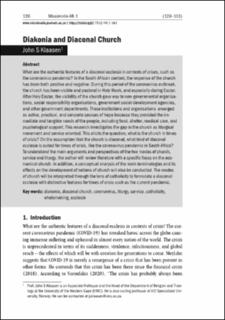| dc.description.abstract | What are the authentic features of a diaconal ecclesia in contexts of crises, such as the coronavirus pandemic? In the South African context, the response of the church has been both positive and negative. During this period of the coronavirus outbreak, the church has been visible and pastoral in Holy Week, and especially during Easter. After Holy Easter, the visibility of the church gave way to non-governmental organisations, social responsibility organisations, government social development agencies, and other government departments. These institutions and organisations emerged as active, practical, and concrete sources of hope because they provided the immediate and tangible needs of the people, including food, shelter, medical care, and psychological support. This research investigates the gap in the church as liturgical movement and service oriented. This elicits the question, what is the church in times of crisis? On the assumption that the church is diaconal, what kind of diaconal ecclesia is suited for times of crisis, like the coronavirus pandemic in South Africa? To understand the main arguments and perspectives of the two modes of church, service and liturgy, the author will review literature with a specific focus on the ecumenical church. In addition, a conceptual analysis of the main terminologies and its effects on the development of notions of church will also be conducted. The modes of church will be interpreted through the lens of catholicity to formulate a diaconal ecclesia with distinctive features for times of crisis such as the current pandemic. | en_US |

